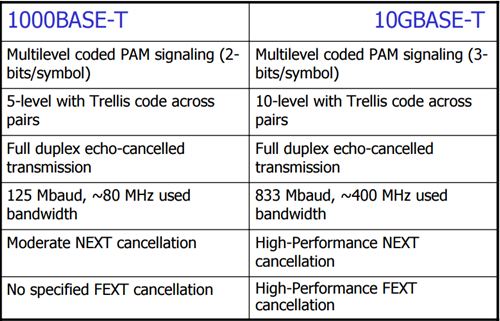With the requirements laid on data center increasing rapidly, the ability to flexibly adapt to future demands is tremendously crucial for data center managers. Often this can be achieved by deploying higher bandwidth solutions in a part of the data center, provided that these systems are backwards compatible with existing infrastructure or it may be a cost-consuming method. BASE-T technology featured by its low cost, availability and flexibility is largely favored by data center designers. This article illustrates the migration of BASE-T technology so that people can future proof their data center tomorrow.
Why BASE-T Is so Popular?
To be short, three main advantages will be concluded in the following part.
1. Least cost access layer alternative when compared to other interconnect technologies
- Optical (e.g. SR, LR)
- Direct-Attached
2.Structured topology
- Common physical interface (RJ45)
- Flexibility and longevity
- Optimized for small to medium-sized data centers (< 20K square feet)
3. Supports auto-negotiation and Power-Over-Ethernet
- Simple plug and play installation
- Ubiquitous RJ45 interface simplifies 10GBASE-T to 40GBASE-T upgrade path
1000BASE-T—Gigabit Ethernet Over 4-pair Cat 5 Cabling
1000BASE-T (ratified in 1999) is a Gigabit Ethernet standard over copper wiring at the speed of 1000 Mbps. Each 1000BASE-T network segment can support a maximum length of 100 meters, and uses Category 5 cable or better (including Cat 5e and Cat 6). 1000BASE-T also uses a symbol rate of 125 Mbaud and all four pairs for the link and a more sophisticated five-level coding scheme. The 1000BASE-T SFP operates on standard Category 5 unshielded twisted-pair copper cabling of link lengths up to 100 m.
Realizing 10BASE-T
Upgraded from 1000BASE-T, 10GBASE-T (certificated in 2006) offers the most flexibility, the lowest cost media, and is backward-compatible with existing 1 GbE networks. 10GBASE-T connected with Cat 6 and Cat 6A (or above) cabling supports a length up to 100 meters that gives IT managers a far greater level of flexibility in connecting devices in the data center. 10GBASE-T and Category 6A cabling costs less than using either optical fiber or SFP+ direct attach copper (DAC) options that have been widely deployed to date center for 10 Gb/s. For example, EX-SFP-10GE-DAC-1M can only support a link length of 1m that largely limits its application. Figure 1 presents a comparison between 1000GBASE-T and 10GBASE-T.

Road to 40GBASE-T in Data Center Networks
If there is a 10GBASE-T for switch-to-server and switch-to-switch connectivity, there will be a 40GBASE-T over twisted pair cabling for the 40G data center deployment according to the IEEE. Twisted pair cabling with the RJ-45 connector has always been the first choice for IT professionals, based on its low cost and ease of use. Unlike fiber or twinax solutions, twisted pair cabling can automatically switch to different data rates, such as from 100MbE to 10GbE. Therefore migration to 40GBASE-T does not require a upgrade of all the equipment of the data center, which will reduce of the overall expenditure of the data center.
The advantages of 40GBASE-T are clear, but the path from initial ratification to commercial availability is not always smooth. There still a few months off for 40GBASE-T standardization, here comes some good news, as well as some considerations.
40GBASE-T is specified with transmission performance up to 2 GHz (four times the bandwidth of Category 6A) with a lot more stringent alien crosstalk requirements. Since initial 40GBASE-T applications would be limited to data centers, the traditional twisted pair Ethernet 100m link length is not essential. Additionally, Industry players helping in the development of an industry standard for 40GBASE-T have to ensure that it could be supported and rolled out cost-effectively. The new standard will minimize the time it will take to develop new electronics for switches and servers that can support 40GBASE-T connectivity, by building on the work already completed to support 10GbE connections. The standard will also support the ubiquitous RJ-45 connector. Sooner or later, 40GBASE-T will be upon us. Nowadays 40GBASE-LR4, 40GBASE-SR and 40G QSFP+ cables are there to help with the deployment of 40G connectivity. Take JG330A as an example, it is QSFP+ to 4SFP+ Passive Copper Cable available for short reach application. Figure 2 shows a data center twisted-pair migration roadmap.

Summary
BASE-T technology (1000BASE-T, 10GBASE-T or 40GBASE-T) always retains the traditional advantages—low cost, easy to deploy and auto-negotiation for plug and play and backwards compatibility. 1000BASE-T and 10GBASE-T have already brought benefits to people. But no one can foresee that 40GBASE-T will be used in the future but future-proof planning of the cabling is important, given the long life of the cabling systems. Fiberstore provides a full range of BASE-T products including 1000BASE-T SFP, 1000BASE-T media converter, 1000BASE-T GBIC transceiver, etc. And 40GBASE-T devices will be coming soon. If you have any request of our products, please send your inquiry to us.
